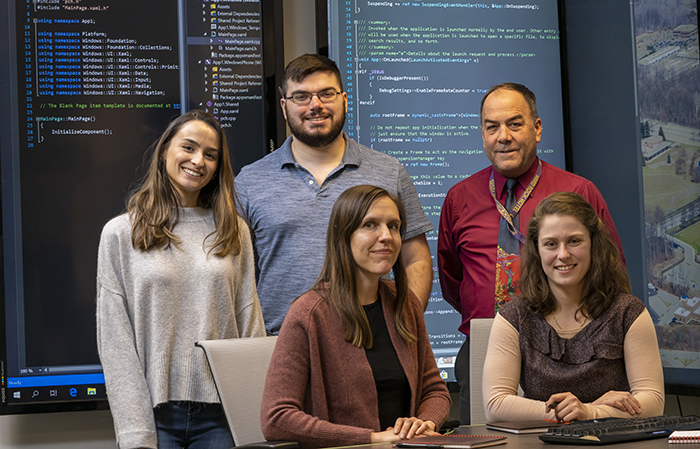Feature Story
College Partnership Becomes a Unique STEM Job Opportunity
What started as a simple solution to a Force Projection Sector project challenge at APL has flourished and grown into a tailored job — and STEM mentorship opportunity — for Howard Community College students.

Photo credit: Johns Hopkins APL
It started as a simple solution to a challenge.
A few years ago, Tom Spriesterbach, supervisor of the Force Projection Sector’s Special Concepts and Engineering Development Group who oversees projects involving physics-based simulations and interactive visualizations, was leading a team at the Johns Hopkins Applied Physics Laboratory (APL) developing the Virtual Instructor Program, a tool the Navy and Air Force use to train members on specific job tasks.
Spriesterbach needed software testers who could evaluate the program and look for any errors that needed fixing. The trouble, he soon found, was that the role was a bit unique. Commercial industry frequently utilizes software testers, or test engineers, but they are harder to come by in academia.
“In an academic environment, we are concerned about creating a prototype [instead of the actual software], and software testing by the developers is typically sufficient,” explained Spriesterbach.
The software his team was creating delivered new features to warfighters on a fairly frequent basis, so having agile testers who could ensure the quality and usability were up to par was critical.
As an engineer, he was no stranger to taking an analytical approach to a problem, so he went back to the drawing board. He asked himself and group leadership some clarifying questions: Who are we looking for? Who would make a good tester? The longer they marinated on the topic, the more often STEM students came to the fore as his solution.
Working at APL opened my eyes to the number of opportunities in STEM fields and has encouraged me to continue my formal and informal education.
Students could be molded into the role, Spriesterbach reasoned, while getting the chance to work part-time, receive tuition assistance and cut their teeth on programming. In turn, APL would provide mentoring and education to further the students’ academic and professional development. He found his solution just four miles down the road.
“We turned to Howard Community College because of the quality of the STEM program and the instructors,” he said.
Spriesterbach’s contacts in HCC’s Science, Engineering and Technology Department pointed him toward Paul Hogan, a popular computer science instructor.
“The reputation of the Johns Hopkins Applied Physics Lab is highly regarded locally and globally,” Hogan said. “We recognized what a tremendous opportunity this was for our students and knew we had to pursue it.”
Hogan tapped HCC’s computer science program and dipped into the STEM extracurricular programs and workshops for interested applicants. Spriesterbach pitched the opportunity to Hogan’s selected pool of about 25 students. The program wasn’t an internship, Spriesterbach explained, but rather a flexible part-time job that required a formal interview. The role would allow students to simultaneously attend school and work at APL throughout the year.
Spriesterbach soon found who he was looking for.
The Student Solution
Vanessa Rodgers was in the computer science program and a part of HCC’s Women in Tech, an experiential learning group that gives female students an opportunity to work on STEM-related projects outside the classroom. In 2017, when she was the first to join Spriesterbach’s project, Rodgers already had a foreign-language degree but wasn’t sure how to parlay those skills into a full-time role. She had decided to go back to school and explore STEM.
We want to encourage these students’ growth and development and move them forward.
As a nontraditional student, she chose HCC for its flexibility and the school’s consistently solid reputation. There, she was encouraged by academic advisors to explore web development. “It was both creative and in demand,” she said, acknowledging that it was also “a huge career change” for her.
Hogan, Rogers’ teacher and STEM club mentor, recognized her academic abilities and encouraged her to apply for the APL position.
Alex Gonzalez followed soon after. After attending the University of Maryland, College Park, she too had pivoted to HCC to pursue an associate’s degree in computer science.
“I have always been interested in computers and excited by the potential of technology,” Gonzalez said. “I knew a career in STEM would be rewarding and offer continuous discovery and knowledge, while making an impact on society.
“Growing up in the area, I had always heard of APL and the impact of the organization in research worldwide. When I was approached by Tom for the opportunity, I knew I would be proud to work for a place like APL.”
Rodgers and Gonzalez dove into their roles, working on software development and testing for both virtual reality (VR) and non-VR simulation software. The APL team hit a stride with the new partnership: Spriesterbach and his group had dedicated testers, supervised directly by Jessica Hatch, and the students were getting on-the-job experience that propelled them in their studies.
“Working at APL opened my eyes to the number of opportunities in STEM fields and has encouraged me to continue my formal and informal education,” Rodgers said. She is completing the final prerequisites before pursuing a master’s degree in computer science from the Johns Hopkins Engineering for Professionals (EP) program.
[This partnership] has allowed me to do work that I not only find meaningful, but also incredibly interesting. I find myself solving problems I never knew existed or thought I could solve.
Meanwhile, Gonzalez moved on from HCC and juggled her tester role with earning a bachelor’s in computer science at Towson University. “Working at APL motivated me even more to do well in my educational career and gain as much knowledge as possible. It also encouraged me to take on challenges and explore new realms of computer science,” said Gonzalez, who is now also taking computer science graduate courses in the Johns Hopkins EP program.
The most recent addition to the group is Jake Hoffman, who joined APL a little over a year ago. Hoffman got involved in computer science at HCC and learned about the APL partnership through his classes.
“I enjoyed learning about math and was just interested in it in general. Prior to that I had no idea that I could even code something at all, much less major in it,” said Hoffman, who completed his associate’s degree in general studies at HCC and is set to earn a bachelor’s in computer science from the University of Maryland, Baltimore County, in May.
Opportunities to Grow
What began as a short-term solution has turned into a tailored job opportunity that diverges a bit from the traditional internships APL offers, allowing the selected students to work throughout the year and to take on as much — or as little — as they want depending on their academic demands.
“Tom and his team are doing great work investing in the local community,” said Carrie Gingras, of APL’s Talent Services Department, who worked with Spriesterbach and his team during the hiring process. “We encourage hiring teams to develop these kinds of relationships and to partner with us to explore new ways to engage with the community.”
“This role isn’t easy, but we try to strike a balance,” said Spriesterbach. “We want to encourage these students’ growth and development and move them forward. And then we’ll plan to replace them with other testers as they move on to fill other computer engineering roles.”
Hoffman is now considering graduate studies, something he said he never thought he could tackle mentally or financially before working at APL. “Furthermore, [this partnership] has allowed me to do work that I not only find meaningful, but also incredibly interesting,” he said. “I find myself solving problems I never knew existed or thought I could solve.”
